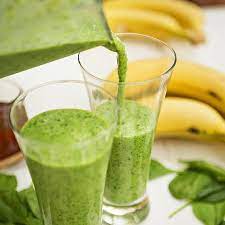
Smoothies were invented in health-obsessed California. It is essentially a fruit smoothie prepared in a blender, but very thick. The difference between a smoothie and a regular smoothie is that it is not made from juices, but from pureed or even whole fruits. Thus, a smoothie contains much more fiber. And as a consequence, it is very good for digestion and in general. Serve smoothies to the table with two straws – first, it’s customary, and second, it’s more convenient.
In the ’60s the world went crazy with this simple and stunningly appetizing find. Today, a smoothie, or smoothies, or smoothies (from the English word smooth – “homogeneous, soft, smooth, pleasant”) – a thick whipped drink from a mixture of fruits, vegetables, milk / ice cream / cream / yogurt, with the addition of nuts, granola, chocolate and honey – has become the basis of a new trend in the field of healthy eating. Millions of followers of the smoothie diet consider these smoothies to be a great way to lose weight and maintain vitality.
The history of the origin of this “food in a glass” is quite interesting. According to one version, it was invented by Pacific surfers, who refreshed themselves with such a drink between two waves. It is also said that the fashion for smoothies was started in the 60s by the “flower children” – the hippies. And the name “smoothie” itself got into the history through the light hand of Stephen Coonau, the founder of the Smoothie King chain of cocktail bars, who supposedly invented it in those years.
But the industrial history of smoothies is directly connected with the Olympics of 1984 in Los-Angeles, especially for which these original and healthy drinks were developed. The miracle antidote to hamburgers and hot dogs was revealed to the world. And Americans proclaimed their star-spangled homeland the discoverer of thick smoothies.
Although smoothie analogues have existed in various nations since the dawn of time.
For example, the ancient Indians drank guava juice with pulp before hunting or battles to strengthen the spirit and gain stamina.
Polish nobles drank a drink made of beer, a few eggs and thick sour cream before battle. And the Slavic oatmeal kissel, which is described in the “Tale of Bygone Years”? Or Indian rice drink and all kinds of French mashed potato soups? What is not a smoothie?
Nutritionists recommend eating light fruit smoothies for breakfast and nutritious vegetable smoothies for lunch and dinner. Although the order may not be followed.
“A sip at lunch is half a day off” is why smoothies are so popular with white-collar workers, athletes, travelers and students. In addition, everyone loves such storehouses of vitamins and minerals: it is the most delicious way to cope with appetite!
Vegetable smoothies are made from tomatoes, carrots, beets, avocados, cucumbers, pumpkins, bell peppers, cabbage with the addition of “green” vitamins – ginger, parsley, basil, coriander, celery, spinach, and all kinds of spices and herbs.
In a nutshell, the smoothie bible looks like this:
Make your own smoothies.
Use nonfat kefir, yogurt or cottage cheese instead of fatty milk and sour cream, honey and flower pollen instead of sugar.
Try not to salt vegetable smoothies: it is more useful to add ground dried seaweed and spices.
You can include in smoothies protein or soy powder, multivitamins, flax seeds or sprouted wheat: with their help you can increase the content of protein and nutrients.
For weight loss in fruit smoothies, use less caloric fruits and berries – apricots, tangerines and black currants: they have 0% fat. Low-fat products can also include apples, grapefruit, pineapples, pomegranates, cherries. But bananas, grapes, avocados, watermelon, melon and peaches should be avoided.
The most potassium is contained in cherries, tomatoes and apricots, sodium – in beets, carrots and tangerines, calcium – in black currant and lemon, and phosphorus – in black chokeberry, tomatoes and rose hips.
And most importantly, stock up on thick tubes!